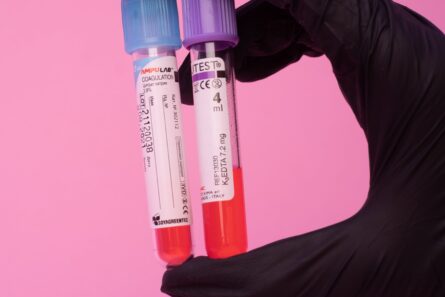Explainer Episode 62 – FDA’s Regulation of Laboratory Developed Tests

For many years FDA has claimed the authority to regulate Laboratory Developed Tests, that is tests that are designed, produced, and used in a single lab – never being put up for sale. This authority, however, has been contested, and the FDA itself has traditionally practiced “discretionary enforcement,” wherein it has regulated LDTs very little. A change occurred in October 2023 when the FDA issued a notice of proposed rulemaking wherein it indicated its intention to codify its claim of authority and begin enforcing oversight of LDTs. Dr. Joel Zinberg, M.D., J.D., joined us to discuss the history of the FDA’s regulation of LDTs, the proposed rule, and what the ramifications may be.
Featuring:
- Dr. Joel Zinberg, Senior Fellow, Competitive Enterprise Institute
Transcript
Although this transcript is largely accurate, in some cases it could be incomplete or inaccurate due to inaudible passages or transcription errors.
[Music and Narration]
Introduction: Welcome to the Regulatory Transparency Project’s Fourth Branch podcast series. All expressions of opinion are those of the speaker.
Chayila Kleist: Hello, and welcome to this Regulatory Transparency Project podcast. My name is Chayila Kleist, and I’m an Assistant Director of Practice Groups and the Regulatory Transparency Project here at the Federalist Society.
Today we’re delighted to host Dr. Joel Zinberg for discussion on the FDA’s claims of authority to regulate Laboratory Developed Tests.
Dr. Zinberg, thanks so much for joining us today. We really appreciate you taking the time.
Dr. Joel Zinberg: My pleasure. Thanks for having me.
Chayila Kleist: For our audience, Dr. Zinberg, M.D., J.D., is a Senior Fellow at the Competitive Enterprise Institute and the Director of the Paragon Health Institute’s Public Health and American Well-Being Initiative. He’s a native New Yorker who recently completed two years as General Counsel and Senior Economist at the Council of Economic Advisors in the Economic — sorry, the Executive Office of the President.
Further, he practiced general and oncologic surgery in New York for nearly 30 years at Mount Sinai Hospital and Icahn School of Medicine, where he is an Associate Clinical Professor of Surgery. Dr. Zinberg also taught for ten years at Columbia University Law School, where he was Lecturer in Law.
He served for many years on New York’s State Board of Professional Medical Conduct and on Mount Sinai’s Ethics Committee and Institutional Review Board. He is a past President and Trustee of the New York County Medical Society.
Dr. Zinberg has also written for publications as varied as the Journal of the American Medical Association, Bulletin of the American College of Surgeons, The Wall Street Journal, City Journal, and law reviews.
Now, there’s certainly more to say, but in the interest of getting to our discussion, I will leave it there. Although, if you’d like to know more, you can access Dr. Zinberg’s impressive full bio at regproject.org. With that, however, let’s get to the discussion.
Dr. Zinberg, starting at the beginning, what are Laboratory Developed Tests, and who uses them?
Dr. Joel Zinberg: So, Laboratory Developed Tests—or as they’re known by their shorthand, LDTs—are tests that are designed and manufactured and used within a single laboratory. And it’s generally a laboratory that’s certified to perform high-complexity testing under CLIA, the Clinical Laboratory Improvement Amendments of 1988.
So these have usually been tests that are created by highly respected academic and public health laboratories in response to an unmet clinical need or where there’s — existing diagnostic tests are inadequate. So, for example, LDTs were developed for emerging infectious diseases such as HIV, SARS, H1N1 influenza long before FDA-approved tests were available. Other times, tests have been created for rare genetic conditions that have been seen in the laboratory’s patient population or cancer biomarkers, or to track drug levels when they’re of use to clinicians who work in those laboratories.
And while the FDA has long claimed authority to regulate LDTs, it’s almost never done so. LDTs have instead been regulated by CMS, the Centers for Medicare and Medicaid Services, under CLIA.
Chayila Kleist: Got it. And so, given that there’s been this long claim to power, but it hasn’t always been used, why are we talking about this now?
Dr. Joel Zinberg: Well, look, we’re talking about it now because the FDA, for the first time in its history, has advanced a rule through notice-and-comment rulemaking, asserting its authority to regulate LDTs. And there’s no question that the Food, Drug, and Cosmetic Act gives the FDA broad authority to regulate medical devices. And that’s defined as things that are intended for use in the diagnosis of disease. And in particular, the 1976 Medical Device Amendments under the Act give the agency the ability to conduct premarket review of diagnostic tests.
But while those amendments give the authority to regulate diagnostic tests that are manufactured by one entity and sold to other laboratories, it’s less clear that the statute gives the authority to regulate LDTs, which, as I mentioned earlier, are manufactured and used within a single laboratory. So the FDA has claimed they have this authority to regulate LDTs for at least 30 years, but it’s never enforced it. It always cites enforcement discretion, saying that LDTs do not need to comply with normal FDA regulations that require devices to undergo premarket review and to receive approval or clearance or authorization from the agency. So now the FDA, for the first time, is now saying it’s going to go ahead and exercise that authority through rulemaking.
And it’s worth noting that in the past, the FDA has, on multiple occasions, asserted that it would have guidance outlining this authority, but it’s actually never finalized that guidance. So this is the first time that the FDA is actually resorting to rulemaking to do this. And this proposed rule that they issued in October of 2023 explicitly states that in vitro diagnostic products are devices under the Food, Drug, and Cosmetic Act regardless of where they’re made and used and who else regulates them, including—and this is the key language—when the manufacturer of the IVD is a laboratory.
So to me, this raises multiple questions. First of all, does the FDA really have statutory authority to regulate LDTs, and is it a good idea for them to do so? I think that the FDA’s proposed rulemaking likely exceeds the agency’s statutory authority and will be counterproductive, decreasing the innovation and diagnostic testing that’s needed in general, and that is particularly valuable in emergencies and for combating emerging infectious diseases. And the result will leave the nation less prepared to the next medical emergency.
Chayila Kleist: Thank you. And I’ll be interested to get into the potential ramifications of this decision a little further in the podcast.
But for now, I’d love to ask a question about the potential impacts practically. Since the FDA has long claimed this authority but has used discretionary nonenforcement, what would this proposed rule actually change on the ground for labs, for the FDA? Since these tests are already regulated under the CLIA, what would change practically?
Dr. Joel Zinberg: Well, it would be a tremendous change, because the situation now is you have some 12,000 laboratories across the country that fall into the what’s called CLIA level three labs—high complexity labs—and these are sophisticated labs. They’re free to create these new tests for these unmet clinical needs. And they can do it with very little limitation, and more importantly, in response to clinical needs that clinicians are expressing to them. And they’re regulated by CLIA, but they’re regulated for what’s called analytic accuracy. So in other words, what the CLIA is finding out, making certain, is that if they say they’re testing for item X, that indeed it is an accurate test for item X.
What they’re not doing is testing for what the FDA terms as clinical accuracy, which means that item X indicates that there’s a particular clinical problem that this patient might have. And what we have — a situation now is that you’re relying on the expertise of the laboratories to come up with these new methodologies and testing services. And then you’re relying on the expertise of the clinicians who order them and utilize the results. If you take that away, and you set up a system where FDA has to approve each one of these new tests, or at least do some premarket review, you’re going to limit the amount of innovation that can take place because it’s going to take a lot more time to get these things online, and it’s going to take a lot more money, and FDA’s own estimates of what this is going to cost are really substantial. So they are predicting that you’re going to have something like I think the figure is $35.5 billion of compliance costs over the four-to-five-year phase in of their rule. And then there’ll be ongoing recurring costs of $4.2 billion a year.
And they themselves acknowledge that this is going to drive a lot of these small laboratories that comprise about half of the Laboratory Developed Tests on an annual basis out of business, or at least, at minimum, limit the amount of Laboratory Developed Tests they offer. So this is a substantial burden on these folks. In fact, their economists say that they figure the annualized cost per entity would be about 23 percent of their receipts, which is obviously a substantial amount of money, particularly for a small laboratory. So they themselves acknowledge this is going to drive these folks out of business.
And not only will you not have these new tests that I described, fitting within the definition of LVTs are modifications of FDA-approved tests that many of these laboratories often undertake. And it may be something very simple where they find that if they alter some step within the test or add some new step, that it works much better than what the FDA approved, or it works better for their patient population. Again, these would all technically be new tests that need FDA premarket approval under this proposed rule. So this would be a tremendous step backwards.
And I think if you really want to get a flavor for what would happen, you have to look to one of the few times where the FDA didn’t utilize enforcement discretion. And that happened during the COVID pandemic. So, amazingly, during the biggest public health emergency in over 100 years, the FDA decided that instead of utilizing tests that some academic and public health laboratories had developed for COVID at the beginning — at the end of January of 2020 and the beginning of February of 2020, they were now going to require an FDA process to approve these tests.
And what happened was, at the end of January, a public health emergency was declared by the HHS secretary, which enabled FDA to utilize what’s called emergency use authorization. Now, an emergency use authorization is, when you’re dealing with commercial entities, it’s a tremendous way of expediting things because you no longer have to go through full FDA approval. So, yes, for drugs and tests and things like that, it was going to speed things along. But when you were dealing with LDTs, it actually slowed things down. And when the University of Washington wanted to use a COVID test it had developed, FDA told them not to. And when a trade organization approached the FDA and HHS about getting an exemption from this EUA requirement, they were told, no, you have to go through it.
So what happened was, in February of 2020, the only EUA-approved-for-COVID test was actually for CDC’s COVID test, and that was a flawed, unreliable test that was apparent very early on, after a week or two, but CDC and FDA insisted for the entire month of February that that was the only test that they would approve. And as a result, we had no real COVID testing for the entire month of February as the disease spread around the country. And that was a disaster. And it was only when administration officials actually stepped in and said, no, for COVID tests, you can no longer require the EUAs, and then actually later on in August of that year, told FDA that they were going to limit its authority to approve LDTs in general, that we had any kind of progress. But that gives you a flavor of what would happen if we were to utilize this rule and that it be finally approved.
Chayila Kleist: Okay. And I think that segues nicely into the next section I had, which is: What are the potential outcomes? Given that I think we have a proposed rule that hasn’t been finalized, there’s a couple of routes forward. And we can continue on with the hypothetical you were working with earlier of what happens if this proposed rule comes to be. Do we have a sense for what the impact of that—you’ve touched on this a little bit—along with costs as well as how FDA has acted in the past? But do we have a sense of what approval timelines for LDTs would be, for the requirements that would be put on labs, how that would work out? What are the potential outcomes?
Dr. Joel Zinberg: Well, as I said, the potential outcome is a marked decrease in innovation, which would be a terrible outcome in and of itself. As to what timelines are, it’s very difficult to know, but it’s not at all clear that the FDA can handle the increased workload.
And again, I’d go back to the COVID experience. When FDA looked at its own experience, it found that it had a big backlog of EUAs for COVID tests when it — approximately a year after it started doing this. So it had about 285 LDTs and 85 commercial LDTs—not LDTs, excuse me—commercial manufacturers’ tests—that it did not even get to start reviewing more than a year after it had put out this requirement of EUAs. So clearly, it’s not so certain that with their current resources, they’ll be able to review all these things.
And FDA has estimated it’s going to cost about $3.5 billion just to review existing LDTs, and that there are going to be significant expenditures to review new LDTs. And while the rule contemplates some user fees, they also say that those user fees will not cover all of the expenses. So it’s not sure how this is going to play out, if indeed the rule is finalized, whether they’ll even be able to implement it.
Chayila Kleist: Got it. Beyond flipping to the other side, then, of the cost-benefit structure, you mentioned the costs that could be imposed upon labs. Do LDT manufacturers have—or are they able to be equipped to have—the knowledge or capability to know what’s required in these kinds of applications? Since they haven’t been required under the CLIA, is there a whole new set of knowledge and training and reports and whatever else that they would need in order to be able to comply?
Dr. Joel Zinberg: Well, what GAO found when it looked at this and FDA itself found was that, particularly for EUAs, the laboratories themselves were completely confused and did not receive clear instruction from FDA on how to apply, so they’re just not used to dealing with this. So there’s going to be, at minimum, a learning period for these laboratories to comply with FDA requirements.
But arguably, a lot of the laboratories are just not going to bother. They’re going to not deal with it. And unfortunately, the bigger manufacturers are going to be the beneficiaries here. When you have these smaller, innovative laboratories dropping out of the market, all that happens is that bigger labs and the commercial labs will step into the space, and you’re going to have decreased competition in terms of numbers of new tests or competition for existing tests, and that will result in higher prices. And consumers and patients are the ones who are going to suffer from that.
Chayila Kleist: Got it. So given that the costs and the bandwidth required if this regulation passes—assuming it does—what are the potential outcomes? Is the regulation likely to stand? You’ve mentioned there’s questions as to whether or not FDA was actually given this authority in the statute. Obviously, there have been conversations at the Supreme Court concerning questions of major economic impact and whether or not agencies can make claims to authorities that aren’t expressly in the statute when there is significant economic impact. What are the potential outcomes there?
Dr. Joel Zinberg: Well, it’s not at all clear that the FDA has the authority under the existing law to regulate LDTs. So, as I said before, there’s no question they have the authority to regulate things that are manufactured and commercially distributed to third parties. But it’s not clear that the statute gives them the authority to regulate these particular laboratories.
So, for example, the 1976 Medical Device Amendments don’t mention laboratories. They don’t mention lab tests. And they don’t mention laboratory testing services. You just don’t find those mentioned there. Moreover, it’s not at all clear that LDTs are medical devices. They seem to more neatly fit into what we would call as a medical service.
So, for example, the statute defines a device as an instrument, an apparatus, an implement, a machine, a contrivance, a reagent. These all sound like physical articles or products. But in fact, these Laboratory Developed Tests are much more like a methodology or a process that’s developed in-house that will generate results for medical practitioners. So it’s more like a service that incorporates proprietary methodologies than a physical object. And even though they may use physical objects, including FDA-approved devices, that doesn’t turn them into devices. So you have a situation where the scientists and physicians within a laboratory are utilizing their expertise to create new tests, and they’re kind of utilizing their medical practice knowledge.
And on this other hand, you have physicians who are ordering these tests and utilizing the results, and they’re utilizing their medical knowledge to interpret the results and decide whether they’re worthwhile. In other words, they’re making their own assessment a clinical validity. And that sounds much more like medical practice than it does creating a device that’s developed under the FDCA. And in fact, the statute explicitly prohibits the regulation of the practice of medicine at 21 U.S. Code 396. So that’s the second thing to do.
And there’s other areas within the statute that also could give you pause. So, for example, the statute’s premarket review requirements say that it applies to persons who introduce devices interstate commerce for commercial distribution. So again, with these laboratory kits that go to many — created that go to many labs, there’s no problem there. But the FDA’s own definition of commercial distribution actually excludes the movement of devices or products within one establishment or within the same group or subsidiaries of one specific company. So that sounds much more like Laboratory Developed Tests, which, by definition, are manufactured and utilized within one specific laboratory. So that, again, sounds like the statute doesn’t apply.
Plus, interestingly, as I said, the statute refers to a person who introduces a device into interstate commerce. And the HHS general counsel actually looked at the statutory language back in June of 2020, and he wrote that the statute excludes states from the definition of persons. And in fact, most of the laboratories that create LDTs are state-run public health laboratories or university laboratories. So he specifically says states do not fulfill the definition of persons within the statute. So again, it’s another reason within the statute to think that it doesn’t apply.
So if you take all of these things together, the lack of specific language within the statute authorizing regulation of laboratories or laboratory services, plus all these features within the statute that seem to indicate that it was not meant to apply to LDTs, you really look like you’re running afoul of recent Supreme Court decisions dealing with, as you said, questions of great economic or political importance.
The Supreme Court in the West Virginia case made it clear that they want to see clear congressional language authorizing an agency to do this regulation. And I think you just do not have that here. It’s missing, and they probably would not survive a challenge. And it’s pretty clear that there will be a ton of challenges the minute this rule is finalized.
And I think it won’t just be that you have this lack of specific statutory language. You have the situation where, even though the FDA has claimed this authority for years, they’ve actually never really enforced it. And in other case law, the Supreme Court has said, when you look for an authority from a statute that’s been in existence for many years, but you’ve never enforced it, we’re going to be pretty skeptical of you doing that.
And you had an example of that with the OSHA case dealing with mandates for the COVID vaccines. They said that when you have a situation where you’re going to require 84 million Americans to obtain a COVID vaccine or undergo weekly testing at their expense, it’s telling that in a half century of OSHA’s existence, it never relied on this authority to regulate occupational hazards before. So they’re going to be very skeptical about that.
And the very fact that Congress, number one, created in 1988 the authority to regulate LDTs under CLIA suggests that they thought that was a different — that LDTs should be presented different regulatory challenges and should be regulated under a different scheme than the FDA. And it also suggests that they didn’t think the 1976 medical device amendments covered LDTs. Otherwise, why create a new regulatory apparatus if you thought that you had an existing one that covered it?
Finally, you also have a situation where there have been proposals in Congress to enact legislation that would specifically give FDA the authority to regulate LDTs. And in particular, there’s something called the VALID Act, which stands for the Verifying Accurate Leading-edge IVCT Development Act, that was first proposed in 2018, has been proposed multiple additional times, but has never passed. But the point is, why propose a statute if you think the FDA already has the authority to do it?
Chayila Kleist: Got it. Thank you. That’s all very helpful, not only to understand what the practical potential outcomes of this role, should it come to be applied, and also the potential reactions that may come.
I’d love to pose the alternate hypothetical. I’m not sure how probable it is, but what happens? Since the FDA obviously has proposed guidance in the past and then removed it, claiming this power, there’s been a back and forth about whether or not they’re going to use it. What would happen if the FDA withdrew this proposed rule and did not attempt to put it into effect?
Dr. Joel Zinberg: Well, you — then you go back to the current regime, which I think actually works pretty well. It’s not a — you have a situation where labs are free to innovate, and they do. And you have — the current scheme works pretty well.
And it’s interesting when you look at the FDA rationales for why they’re proposing the rule at this time. So they claim, for example, that the nature of LDTs have changed; that LDTs were originally small-volume tests done in labs serving local communities. They were simple tests. They often replicated other tests. We didn’t need to look at them particularly closely. But now that the tests are much more high-tech, they’re much more high-complex. They’re being utilized for people, not necessarily solely in the local communities, but they’re being utilized by people all over the nation, and therefore they need to be regulated. That’s their number-one claim.
But my argument is they can’t credibly claim that they were prompted to do this because the fact is they’ve been talking about regulating these tests since 1992. And they’ve issued guidance on multiple occasions that they then withdrew, most recently in 2014. And what they view as a criticism that people in many communities can now utilize these tests, I think is a great feature. In other words, if a lab comes up with an innovative test that no other test is available for this particular condition or to test for a particular biomarker or cancer marker, and people all over the country have access to it, that’s great, unless there’s some problem with it.
Now, here’s the second reason FDA claims: They claim that LDTs are less reliable than an FDA-approved test. But the fact of the matter is it’s not at all. The evidence they cite is not really consistent with that point of view. So they say, for example, some EUAs from labs during the pandemic for tests were unreliable. But they don’t then compare them to the tests that were created by actual commercial manufacturers, so it’s completely lacking context.
And as I mentioned, there were all kinds of problems with the EUAs during the pandemic, in large part because the FDA didn’t provide adequate advice and instruction to labs who wanted to apply. And also, there was technical issues because there weren’t adequate samples of the virus or its genetic material, so there we—both commercial manufacturers and smaller labs that make LDTs—were relying on these smaller fragments of the genetic material, which would had — which introduced some problems with accuracy. But that was a problem for both.
And then the FDA talks about some small studies dealing with oncology tests that, oh, they showed that these tests, that LDT tests for oncology markers were inaccurate. But in fact, they completely misinterpret the study. And they ignore that there’s a big literature out there suggesting that LDTs for oncology tests are highly accurate and comparable or give comparable or superior results to commercial tests that the FDA has approved.
So there’s no suggestion that we’re going back to or preserving a regime that is in any way harmful. And I would argue we’re — if the FDA withdraws this regulation, we’re preserving a regime that allows for innovation to take place and allows for innovation to take place very rapidly in emergency situations, which we could have had during the pandemic but did not have because of FDA’s obstruction.
Chayila Kleist: Got it. So NPRM was promulgated in October. I assume the comment period has closed. Do we have a thought on when this rule might drop?
Dr. Joel Zinberg: Well, the FDA suggested in its regulatory framework they were looking for approval by April of this year. And there’s probably a very good reason they’re pushing for that is because under the Congressional Review Act, there’s a limited amount of time that Congress has to review and reverse a rule. And I think they are looking—if they can get this rule out as quickly as possible—to ensure that it would be reviewed by this Congress, not by a new Congress that would come in after the next election. So we expect there’s going to be action by sometime in the next few months.
Chayila Kleist: Okay. Well, we’ll have to watch for around April to see what happens.
That is all the questions I had on the topic. Are there any final thoughts you’d like to add, Dr. Zinberg?
Dr. Joel Zinberg: Yeah. Well, I think this is an important example of an agency trying to fix a problem that doesn’t really exist. This is — you have a system that works reasonably well. It allows for innovation. It allows particularly for innovation in emergency situations where you need a flexible, rapid response by inserting new agency regulation that it’s not at all clear the agency has the resources to implement. You’re going to destroy a system that works pretty well at the moment and substitute one that probably will create impediments to innovation in general and to the important innovation that we need in emergency situations in particular. So I think it’s really a bad rule.
If we think there’s a problem here, this is something that Congress ought to address. And it can address it by taking up the Ballot Act again, or it can address it by some other piece of legislation. But by relying on the FDA to impose, roughly speaking, its existing structure on Laboratory Developed Tests is a tremendous step backwards that we should not take.
Chayila Kleist: Got it. Well, we can wrap it there.
Dr. Zinberg, thank you so much for taking time out of your day today. Really appreciate you joining us and sharing your expertise and insight.
[Music]
Conclusion: On behalf of The Federalist Society’s Regulatory Transparency Project, thanks for tuning in to the Fourth Branch podcast. To catch every new episode when it’s released, you can subscribe on Apple Podcasts, Google Play, and Spreaker. For the latest from RTP, please visit our website at www.regproject.org.
[Music]
This has been a FedSoc audio production.

The Federalist Society and Regulatory Transparency Project take no position on particular legal or public policy matters. All expressions of opinion are those of the speaker(s). To join the debate, please email us at [email protected].








